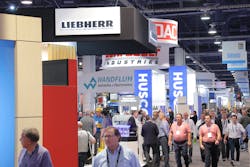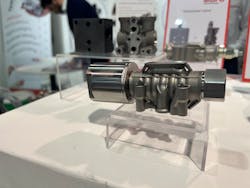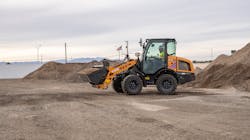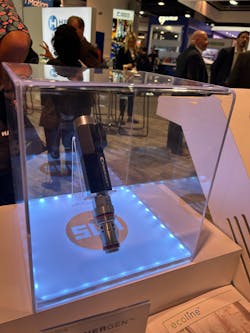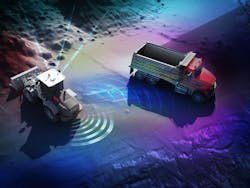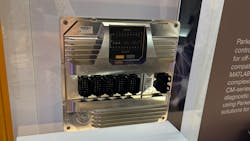*Editor's Note: This article was updated April 2023 with new information.
Once every 3 years the fluid power industry comes together alongside the construction industry – one of the largest users of fluid power components, particularly hydraulics – for the International Fluid Power Exposition (IFPE) and CONEXPO-CON/AGG.
The 2023 edition of IFPE once again highlighted the latest hydraulic and pneumatic solutions, as well as technology advancements in motion control and power transmission.
Marica Klein, Treasurer at Casappa Corp. and chairperson of IFPE 2023, said in an interview with Power & Motion the key themes for IFPE 2023 include:
- sustainability,
- automation,
- digitalization.
These themes are driving many of the technology advancements taking place in the fluid power industry as well as the markets they serve like construction, and several manufacturers will highlight their progress in these development areas during IFPE 2023.
Technology Enables Sustainability
Sustainability can be achieved in many ways, such as reducing fuel consumption, utilizing fewer materials and implementation of new power sources to eliminate emissions. And fluid power components can play an important part in reaching sustainability goals.
Improving the efficiency of fluid power components and systems is one of the many ways the industry is going about doing so. By improving efficiency, overall energy and fuel used by a machine can be reduced which leads to lower fuel costs and emissions.
At IFPE 2023, Danfoss Power Solutions displayed its Dextreme system for excavators; at the heart of the system is the company's Digital Displacement pump (DDP). In place of a standard hydraulic pump is the DDP and a digital pump controller. Leif Bruhn, head of Digital Displacement at Danfoss Power Solutions said in an interview with Power & Motion that this configuration enables up to a 15% fuel savings as well as increases in productivity.
Digital control of the DDP enables more efficient and controlled hydraulic flow which leads to improved system efficiency and faster operator response times. The faster response times and digital control also allows for an excavator’s engine loading to be controlled and thus a significant reduction in fuel consumption without negative impacts to productivity, increasing overall efficiency of an excavator.
The Dextreme system is currently undergoing field trials in England where it will be used in three Volvo excavators. Three versions of the system will be available for customers as well with varying system architectures; each version will provide additional gains in energy efficiency. Danfoss predicts its system will improve excavator efficiency 15-50%, regardless of the machine's power source.
Additive manufacturing, commonly referred to as 3D printing, is bringing opportunities to rethink the design of hydraulic components. Doing so can lead to a reduction in component weight and size, which can reduce overall machine weight to improve fuel consumption.
Valeria Tirelli, president & CEO of Aidro Hydraulics & 3D Printing (a Desktop Metal company), explained in an interview with Power & Motion that additive manufacturing enables less materials and energy to be used than conventional manufacturing methods. It also reduces the amount of tooling necessary for production parts, further benefiting energy reduction.
The ability to create lighter weight parts with additive manufacturing benefits traditional machine designs as well as newer, electric-powered equipment. For electric machines, use of lighter weight components is vital to offsetting the additional weight of batteries.
READ MORE: Additive Manufacturing Brings Opportunities to Improve Component Design and Production
Aidro displayed several fluid power components it has developed using additive manufacturing at IFPE, including a new pneumatic valve for use in explosion-proof environments. Use of additive manufacturing enables the valve to be lightweight and compact, easing integration into a range of machines.
The company is also expanding into use of binder jet 3D printing which will enable higher volume production of hydraulic and pneumatic components.
Also benefiting sustainability initiatives is the development of products from more sustainable materials. This is a key area of development for Hallite Seals; at IFPE the company introduced three new sealing products, all of which can be made from recycled materials. Investments in the company's manufacturing capabilities is also helping to improve the sustainability of its products.
Electrification Provides Opportunities
The transition to electrification is likely what immediately comes to mind when the term sustainability is mentioned. Although there are examples of hydraulics being replaced in some cases, such as the all-electric compact wheel loader developed by Moog and Komatsu, most of the industry agrees there will remain a need for fluid power components in many applications even as electrification increases.
There is yet to be a technology which can provide the power density of hydraulics, benefiting its ongoing use particularly in larger machines. With the advent of electrification, there are opportunities to improve the efficiency of hydraulic systems.
When Danfoss’ Editron division developed a proof-of-concept fully electric wheel loader, it found efficiency gains could be achieved in the hydraulics system. The company was able to do so by rethinking the system architecture and separating some of the machine functions, leading to reduced power consumption and improved efficiency.
The pairing of fluid power and electric components will become more commonplace as electrification progresses. This will be necessary to achieve the efficiency gains desired for electric-powered machines while also helping to improve the performance of fluid power systems.
In a white paper from IFPE organizers, Poclain Hydraulics discussed how there will be a need for intelligent engineering going forward to bring together electric and hydraulic components which will be necessary to optimize performance of electrified machines.
At IFPE, Helios Technologies displayed its recently introduced ENERGEN cartridge valve which converts hydraulic flow into electric energy. During a discussion with Power & Motion at the show, the company said the valve is sort of like regenerative braking for fluid power applications because it enables the conversion of what would be otherwise wasted energy into useful energy.
Several OEMs, particularly those for attachments — which tend to be hydraulically driven — have already expressed interest in the technology the company noted due in part to the growing trend toward electrification.
Bosch Rexroth is one of several fluid power manufacturers which has expanded into the realm of electrification with its eLION platform. Developed specifically for heavy-duty off-highway equipment, the platform includes electric motor-generators, inverters and accessories as well as gearboxes, hydraulics and software components. Components within the platform can be scaled as necessary to help OEMs create hybrid- and full-electric machines.
The company announced at IFPE the addition of a single-phase onboard charger to the eLION platform, enabling use with charging infrastructure in North America.
By developing components for electrified machines themselves, companies like Bosch Rexroth are able to bring their hydraulics expertise and knowledge of the heavy equipment industry. This helps to ensure components and systems will work well together and machine performance is optimized.
The growth of electrification in the construction equipment industry was evident throughout CONEXPO with several OEMs launching new electric-powered machines at the show. Compact machines remain the most common as they are still easier to electrify, but there are efforts to bring electrification to larger machines as well. Volvo Construction Equipment, for instance, showed its electric mid-range excavator, currently undergoing testing in Europe, which it plans to bring to market in 2024.
Automation Brings Technologies Together
With electrification has come the integration of more electronic components in systems and individual components. This is bringing the ability to collect data on performance as well as provide new functionalities such as automation.
Integration of sensors and software is enabling automation of systems and components, including hydraulics and pneumatics. As Peter Bleday, Head of Autonomy at Danfoss Power Solutions, explained in an interview with Power & Motion, many hydraulic components in mobile equipment are now controlled by electronics and software. This enables autonomy to be brought in to control various machine functions—many of which are hydraulically controlled.
Bleday said autonomy is a system-level problem bringing together various components which can include hydraulics and pneumatics. Electrohydraulic, steer-by-wire technology such as Danfoss’ EHi steering valves, for instance, will be integral for enabling autonomous driving.
Danfoss understands the impacts autonomy can have on machines and their systems, which is why it is developing components to work with autonomous systems which it displayed at IFPE. It has also developed the PLUS+1 Autonomy Solution which brings together hardware and software to help OEMs with their machine automation. It provides manufacturers with software blocks containing the necessary information to create autonomous and semi-autonomous systems, helping reduce their development time.
Several companies, including Husco and Helios Technologies, noted during IFPE the growth of electrohydraulics in recent years due in part to rise in automation. Because electronics are built into electrohydraulic components, it is easier to integrate them with other electronic components such as those used for autonomous systems.
READ MORE: Electrohydraulics Benefit Tool Leveling for Telehandlers
Automation can take many forms, from machines capable of working without an operator in the cab to the automation of certain machine movements, such as digging. The latter is the form currently most common in the construction industry. Automating tasks like digging help to minimize the input necessary from operators, enabling them to focus on other work and be more comfortable.
Bosch Rexroth also showcased its technology to aid automation at IFPE which includes integrated technology capable of providing assistance functions for various types of machines. Sensors and software work together with hydraulics to provide driver assistance functions as well as virtual walls — essentially a set barrier which machines cannot move past — and emergency braking capabilities.
By automating certain machine functions, the skills necessary to operate an excavator or other piece of equipment can be reduced. This is becoming an increasingly important aspect due to the lack of skilled labor entering the construction and other heavy equipment markets. The easier a piece of equipment is to use, the faster a new – or even seasoned – operator can get working in a safe, productive and efficient manner.
Improved Data and Maintenance Through Digitalization
In tandem with automation, the increased use of sensors and software is enabling digitalization of fluid power systems. Digitalization is described as the use of digital technologies to enable or improve a process. For fluid power applications, this can already be seen through increased data collection and analysis.
Collecting and analyzing data on component and system performance makes it easier to monitor when a part is starting to wear or fail so machine owners can be more proactive with their maintenance routines.
At IFPE 2023, Casappa showed its smart piston pump featuring the pump, electronic control unit (ECU) and sensors integrated into a single unit. As explained in the previously mentioned IFPE white paper, this design is intended to help enhance digital control of the pump as well as improve efficiency by measuring drain pressure and temperature, speed and load sensing. Performance data collected by the pump’s sensors will be analyzed to help optimize hydraulic power management and provide condition monitoring. The data can also be used to aid with predictive maintenance.
HydraForce recently partnered with Tan Delta and Elevāt to improve maintenance of hydraulic systems. Tan Delta’s oil conditioning sensor will be integrated into manifold assemblies equipped with HydraForce’s cartridge valves for continuous monitoring of hydraulic oil conditions. Information will then be analyzed within Elevāt’s telematics technology and sent to machine owner so they can take timely action on any potential maintenance needs.
Communication of maintenance needs from physical parts is possible due to the Internet of Things (IoT) which enables automatic alerts to be sent based on information collected by the sensors, software and processing built into a system.
READ MORE: IoT Enables Better Problem Solving in Fluid Power
At IFPE, it was indicated during several conversations that oil condition monitoring and interest in IoT have increased immensely since the last show just 3 years ago. With these technologies, enabled in part by the increasing integration of sensors and software, machine owners can better monitor the performance of their machines. Doing so enables them to be more proactive with maintenance, preventing unplanned downtime which can be costly.
Digitalization will work together with electrification and automation to help make systems and overall machines more efficient. Efficiency has become increasingly more important to OEMs and their end-use customers, and further advancements related to these key IFPE themes will only continue due to the benefits which can be provided for both fluid power manufacturers and their customers.
About the Author
Sara Jensen
Executive Editor, Power & Motion
Sara Jensen is executive editor of Power & Motion, directing expanded coverage into the modern fluid power space, as well as mechatronic and smart technologies. She has over 15 years of publishing experience. Prior to Power & Motion she spent 11 years with a trade publication for engineers of heavy-duty equipment, the last 3 of which were as the editor and brand lead. Over the course of her time in the B2B industry, Sara has gained an extensive knowledge of various heavy-duty equipment industries — including construction, agriculture, mining and on-road trucks —along with the systems and market trends which impact them such as fluid power and electronic motion control technologies.
You can follow Sara and Power & Motion via the following social media handles:
X (formerly Twitter): @TechnlgyEditor and @PowerMotionTech
LinkedIn: @SaraJensen and @Power&Motion
Facebook: @PowerMotionTech

Leaders relevant to this article:

